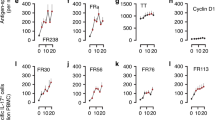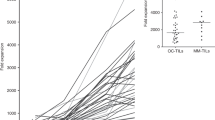Abstract
Background: Tumor-associated lymphocytes (TAL) isolated from ovarian cancer patients contain cytotoxic T lymphocytes (CTL) capable of recognizing specific HLA/peptide complexes on tumor cells leading to tumor cell lysis. Currently, HER2/neu, overexpressed in only 30% of breast and ovarian cancers, is the only known source of CTL-recognized peptides in epithelial cancers. Therefore, we have investigated peptides derived from folate binding protein (FBP), which is over-expressed in more than 90% of ovarian cancers and in the majority of other epithelial tumors.
Methods: TAL were isolated from the malignant ascites of four consecutive HLA-A2+ ovarian cancer patients and incubated in IL-2. Initial chromium-release assays were performed within 1 week. T2 cells, incubated with peptide, were used to reconstitute T cell epitopes. The FBP sequence was interrogated for HLA-A2 binding peptides, and five were synthesized (E37–41).
Results: Freshly cultured, unstimulated ovarian TAL recognize peptides derived from FBP. These peptides are presented in the context of HLA-A2, and are specifically recognized in a HLA class I-restricted fashion. TAL recognition of these reconstituted T cell epitopes is concentration dependent. Furthermore, the FBP peptides are shown by cold target inhibition studies to be naturally processed and presented antigens.
Conclusions: FBP peptides are recognized by freshly isolated TAL from ovarian cancer patients, suggesting in vivo expression and sensitization. Because FBP is over-expressed 20-fold in most adenocarcinomas, these peptides may be used in a widely applicable peptide-based vaccine for epithelial tumors.
Similar content being viewed by others
References
Ioannides CG, Platsoucas CD, Rashed S, Wharton JT, Edwards CL, Freeman RS. Tumor cytolysis by lymphocytes infiltrating ovarian malignant ascites.Cancer Res 1991;51:4257–65.
Linehan DC, Goedegebuure PS, Peoples GE, Rogers SO, Eberlein TJ. Tumor-specific and HLA-A2-restricted cytolysis by tumor associated lymphocytes in human metastatic breast cancer.J Immunol 1995;155:4486–91.
Yoshino I, Peoples GE, Goedegebuure PS, DiMaio JM, Gazdar AF, Eberlein TJ. HER2/neu-derived peptide(s) are shared antigens among human non-small cell lung cancer and ovarian cancer.Cancer Res 1994;54:3387–90.
Peiper M, Goedegebuure PS, Linehan DC, Ganguly E, Douville CC, Eberlein TJ. The HER2/neu-derived peptide p654–662 is a tumor-associated antigen in human pancreatic cancer recognized by cytotoxic T lymphocytes.Eur J Immunol 1997;27:1115–23.
Peoples GE, Schoof DD, Andrews JVR, Goedegebuure PS, Eberlein TJ. T cell recognition of ovarian cancer.Surgery 1993;114:227–34.
Joannides CG, Freedman RS, Platsoucas CD, Rashed S, Kim Y-P. Cytotoxic T cell clones isolated from ovarian tumor-infiltrating lymphocytes recognize multiple antigenic epitopes on autologous tumor cells.J Immunol 1991;146:1700–07.
Peoples GE, Davey MP, Goedegebuure PS, Schoof DD, Eberlein TJ. T cell receptor Vβ2 and Vβ6 mediate tumor-specific cytotoxicity by tumor-infiltrating lymphocytes in ovarian cancer.J Immunol 1993;151:5472–80.
Ioannides CG, Ioannides MG, O'Brian CA. T-cell recognition of oncogene products: a new strategy for immunotherapy.Mol Carcinogen 1992;6:77–81.
Peoples GE, Yoshino I, Douville C, Andrews JVR, Goedegebuure PS, Eberlein TJ. TCR Vβ3+ and Vβ6+ CTL recognize tumor-associated antigens related to HER2/neu expression in HLA-A2+ ovarian cancers.J Immunol 1994;152:4993–9.
Fraumeni JF, Hoover RN, Devesa SS, Kinlen LJ. In: DeVita VT, Hellman S, Rosenberg SA, eds.Cancer: Principles and Practice of oncology. 4th ed. Philadelphia: JB Lippincott, 1993:154.
Peoples GE, Goedegebuure PS, Andrews JVR, Schoof DD, Eberlein TJ. HLA-A2 presents shared tumor-associated antigens derived from endogenous proteins in ovarian cancer.J Immunol 1993;151:5481–91.
Ioannides CG, Fisk B, Pollack MS, Frazier ML, Wharton JT, Freeman RS. Cytotoxic T-cell clones isolated from ovarian tumor infiltrating lymphocytes recognize common determinants on non-ovarian tumor clones.Scand J Immunol 1993;37:413–24.
Peoples GE, Goedegebuure PS, Smith R, Linehan DC, Yoshino I, Eberlein TJ. Breast and ovarian cancer-specific cytotoxic T lymphocytes recognize the same HER2/neu-derived peptide.Proc Natl Acad Sci USA 1995;92:432–6.
Peoples GE, Smith RC, Linehan DC, Yoshino I, Goedegebuure PS, Eberlein TJ. Shared T cell epitopes in epithelial tumors.Cell Immunol 1995;164:279–86.
Fisk B, Anderson BW, Gravitt KR, et al. Identification of naturally processed human ovarian peptides recognized by tumor-associated CD8+ cytotoxic T lymphocytes.Cancer Res 1997;57:87–93.
Henderson RA, Michel H, Sakaguchi K, Shabanowitz J, Appella E, Hunt DF, Engelhard VH. HLA-A2.1-associated peptides from a mutant cell line: a second pathway of antigen presentation.Science 1992;255:1264–6.
Ioannides CG, Fisk B, Fan D, Biddison WA, Wharton JT, O'Brian CA. Cytotoxic T cells isolated from ovarian malignant ascites recognize a peptide derived from the HER2/neu proto-oncogene.Cell Immunol 1993;151:225–34.
Fisk B, Blevins TL, Wharton JT, Ioannides CG. Identification of an immunodominant peptide of the HER-2/neu proto-oncogene recognized by ovarian tumor specific CTL lines.J Exp Med 1995;181:2709–17.
Fendly BM, Kotts C, Wong WLT, et al. Successful immunization of Rhesus monkeys with the extracellular domain of p185HER2: a potential approach to human breast cancer.Vaccine Res 1993;2:129–39.
Slamon DJ, Clark GM, Wong SG, Levin WJ, Ullrich A, McGuire WL. Human breast cancer: correlation of relapse and survival with amplification of the HER-2/neu oncogene.Science 1987;235:177–82.
Slamon DJ, Godolphin W, Jones LA, et al. Studies of the HER-2/neu proto-oncogene in human breast and ovarian cancer.Science 1989;244:707–12.
Garin-Chesa P, Campbell I, Saigo PE, Lewis JL, Old LJ, Rettig WJ. Trophoblast and ovarian cancer antigen LK26. Sensitivity and specificity in immunopathology and molecular identification as a folate-binding protein.Am J Pathol 1993;142:557–67.
Alberti S, Miotti S, Fornano M, et al. The CA-MOv18 molecule, a cell surface marker of human ovarian carcinomas, is anchored to the cell membrane by phosphatidylinositol.Biochem Biophys Res Commun 1990;171:1051–5.
Li PY, Del Vecchio S, Fonti R, et al. Local concentration of folate binding protein GP38 in sections of human ovarian carcinoma by in vitro quantitative autoradiography.J Nucl Med 1996;37:665–72.
Weitman SD, Lark RH, Coney LR, Fort DW, Frasca V, Zurawski VR, Kamen BA. Distribution of the folate receptor GP38 in normal and malignant cell lines and tissues.Cancer Res 1992;52:3396–401.
Coney LR, Mezzanzanica D, Sanborn D, Casalini P, Colnaghi MI, Zurawski VR. Chimeric murine-human antibodies directed against folate binding receptor are efficient mediators of ovarian carcinoma cell killing.Cancer Res 1994;54:2448–55.
Bolhuis RL, Lamers CH, Goey SH, et al. Adoptive immunotherapy of ovarian carcinoma with bs-MAb-targeted lymphocytes: a multicenter study.Int J Cancer 1992;7:78–81.
Mathias CJ, Wang S, Lee RJ, Waters DJ, Low PS, Green MA. Tumor-selective radiopharmaceutical targeting via receptor-mediated endocytosis of gallium-67-deferoxamine-folate.J Nucl Med 1996;37:1003–8.
Leamon CP, Pastan I, Low PS. Cytotoxicity of folate-Pseudomonas exotoxin conjugates toward tumor cells: contribution of translocation domain.J Biol Chem 1993;268:24847–54.
Schultz RM, Andis SL, Shackelford KA, et al. Role of membrane-associated folate binding protein in the cytotoxicity of antifolates in KB, IGROV1, and L1210A cells.Oncol Res 1995;7:97–102.
Fisk B, Chesak B, Pollack MS, Wharton JT, Ioannides CG. Oligopeptide induction of a cytotoxic T lymphocyte response to HER2/neu proto-oncogene in vitro.Cell Immunol 1994;157:415–27.
Fisk B, Savary C, Hudson JM, O'Brian CA, Murray JL, Wharton JT, Ioannides CG. Changes in an HER-2 peptide upregulating HLA-A2 expression affect both conformational epitopes and CTL recognition: implications for optimization of antigen presentation and tumor-specific CTL induction.J Immunother 1996;18:197–209.
Boon T, van der Bruggen P. Human tumor antigens recognized by T lymphocytes.J Exp Med 1996;183:725–9.
Rettig WJ, Cordon-Cardo C, Koulos JP, Lewis JL, Oettgen HF, Old LJ. Cell surface antigens of human trophoblast and choriocarcinoma defined by monoclonal antibodies.Int J Cancer 1985;35:469–75.
Coney LR, Tomassetti A, Carayannopoulos L, Frasca V, Kamen BA, Colnaghi MI, Zurawski VR. Cloning of a tumor-associated antigen: MOv18 and MOv19 antibodies recognize a folate-binding protein.Cancer Res 1991;51:6125–32.
Elwood PC. Molecular cloning and characterization of the human folate binding protein cDNA from placenta and malignant tissue culture (KB) cells.J Biol Chem 1989;264:14893–901.
Rosenberg SA, Packard BS, Aebersold PM, et al. Use of tumor-infiltrating lymphocytes and interleukin-2 in the immunotherapy of patients with metastatic melanoma.N Engl J Med 1988;319:1676–80.
Goedegebuure PS, Douville LM, Li H, Eberlein TJ. Adoptive immunotherapy with tumor-infiltrating lymphocytes and interleukin-2 in patients with metastatic malignant melanoma and renal cell carcinoma: a pilot study.J Clin Oncol 1995;13:1939.
Aoki Y, Takakuwa K, Kodama S, et al. Use of adoptive transfer of tumor-infiltrating lymphocytes alone or in combination with cis-platin-containing chemotherapy in patients with epithelial ovarian cancer.Cancer Res 1991;51:1934.
Melief CJ, Offringa R, Toes REM, Kast WM. Peptide-based cancer vaccines.Curr Opin Immunol 1996;8:651–7.
Mukherji B, Chakraborty NG, Yamasaki S, et al. Induction of antigen-specific cytolytic T cells in situ in human melanoma by immunization with synthetic peptide-pulsed autologous antigen presenting cells.Proc Natl Acad Sci USA 1995;92:8078–82.
Cormier JN, Salgaller ML, Prevette T, et al. Enhancement of cellular immunity in melanoma patients immunized with a peptide from MART-1/Melan A.Cancer J Sci Am 1997;3:37–44.
Anderson BW, Swearingen BJ, Wharton JT, Ioannides CG. Primary generation of human antitumor CTL by a HLA-A2-restricted HER-2 peptide.Proc Am Assoc Cancer Res 1997;38:1606.
Author information
Authors and Affiliations
Rights and permissions
About this article
Cite this article
Peoples, G.E., Anderson, B.W., Fisk, B. et al. Ovarian cancer-associated lymphocyte recognition of folate binding protein peptides. Annals of Surgical Oncology 5, 743–750 (1998). https://doi.org/10.1007/BF02303486
Received:
Accepted:
Issue Date:
DOI: https://doi.org/10.1007/BF02303486




